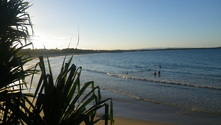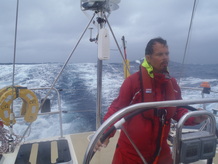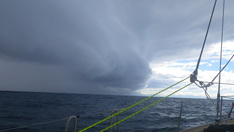Relaxing in Noosa12/22/2011  Main beach in Noosa _I have been spending the last few days in beautiful Noosa on the Sunshine coast, north of Brisbane. It is a small town with a nice beach surrounded by two large national parks. I have taken surf lessons, did some jogging along the coast and did some kayaking on the beach and on the river. Nice, lazy days. I really recommend the hostel where I am staying, Halse lodge. It is very clean, surrounded by trees and it has a big verandah.
17 Comments
Surfing on the Tasman sea12/22/2011 This clip was during a Force 8 gale on the way to the Gold Coast. As you can see on the video, we reached 20 knots while surfing. My top speed in the whole race!  One more gale on the Tasman sea _The stop over in Tauranga was great to recharge the batteries! In Geraldton, after 28 days of sailing, we only had one free day during 5 days on land. It was too short and it caused some problems later on; crew and skipper were stressed out when crossing the Southern ocean towards Tauranga. In New Zealand we had 9 days on land and 5 free days! I had time to bike around town, visit parks with geothermal lakes and go swim in pools filled with geothermal water and I visited a cave with an underwater river inhabited by the famous glow worms. It was great! On Sunday December 4th at 1430 the race to Gold Coast started. It was a very short leg, only 1370 nm and I did not expect too much rough weather; we would sail northwest towards subtropical latitudes and warmer temperatures. Winds up to 20 knots from the NW had us beating along the North island coast for the first 3 days. It was rainy too and not very pleasant. After we cleared the northern tip of the island, the wind backed to the West and we started to reach to Gold Coast, 1000 nm away. The weather cleared up and the sun started to burn. What a difference from sailing in the Southern ocean! One day I was helming at night with the spinnaker up. Suddenly a loud thump was heard and I lost steering. The boat headed up and we broached. The skipper came on deck in a hurry. I thought that the steering cable had broken but the helm was still working. We checked the steering cables and quadrant and everything was ok. Our conclusion was that we hit a large animal with the rudder! Maybe a shark, maybe a dolphin, maybe a big fish, who knows? I wonder if the poor animal survived. A low pressure system hit us when we had 800 nm to go. A gale with winds of 30 knots and gusts up to 50 knots made conditions interesting. We were sailing downwind with a full main and yankee 1. We had too much sail and once in a while we broached; the weatherhelm overpowered the steering and the boat headed into the wind. We also had to be careful not to gybe. Basically we had to steer withing a 30 degree range. The sea state was very confusing; very choppy and with some big waves up to 24 feet (8 m). As a consequence of the big waves, we had some big surf once in a while. At one point I reached 21 knots and Loyd reached 26 knots while surfing. This was exciting! After the gale we were in 4th place. All the boats were packed together a little bit south of the rhumb line. For some reason, not yet clear to me, the skipper decided to tack and head north. I think he was betting on a wind shift that would favor us. This ended up being a bad tactical decision. The wind did not do what he expected and we dropped position to 8th place. We had one day of sun and fair winds and then another gale came through. Wind became steady at 30 knots with gusts up to 40 knots. Even though we usually do better than the other boats during strong winds, this time we did not gain any positions, since we were so far behind. After 9 days we arrived in Southport in the Gold Coast. Visit Finland arrived first, finally breaking the winning streak of Gold Coast, who arrived in second. DLL arrived in third and we arrived in eighth, behind Edinburgh. After 4.5 months and over 17,000 nm I finished my participation in the Clipper race. It was an amazing experience! Racing offshore, helming through storms, changing sails under extreme conditions were moments that I will never forget. However I believe that now is the right time to stop. I have gained the experience that I expected and from now on would be more of the same. Now it is time to relax, enjoy some land traveling in Australia and Southeast Asia before going back to NY in late January 2012. _
 Squall approaching the coast of New Zealand _This leg has been the toughest one so far! We had a constant stream of low pressure systems through the Southern ocean, with little rest in between, we sailed through some violent squalls and during the last 150 nm we were sailing with a 40 knots gale on our nose. The race started on a Sunday, November 6th at 1330. The wind was good, around 15 knots and we were first at the start with Gold Coast (GC) coming second. There were a couple of marks close to the beach that we had to pass before heading offshore. We were plotting and getting their bearing on the go and this was a mistake because we missed one of them and when we noticed our mistake it was too late, we fell to third place. Lesson learned; plot all the marks before the start. The first 24 hs of the race was a reach heading straight south to Cape Leeuwin, the most southwestern point in Autralia, 350 nm away from Geraldton. We stayed more offshore than the other boats, who decided to stay closer to the shore. Later on their tactics payed off because they had a favorable current and had less miles to sail. We were now in 6th place. We should have stayed with the fleet! A big low pressure system was forecasted to pass south of Cape Leeuwin around the time we were supposed to round it. After passing the cape, the wind started to pick up and the seas started to get bigger. These were some of the roughest seas we met so far! The waves were big, some as high as 24 feet (8m). The rough seas lasted 48 hs and we used a main sail with 2 reefs plus the staysail. There were many squalls, one in particular had very strong winds for a minute or so, around 60 knots, where the sea was foaming white. During the night I saw a rare phenomena; a moon rainbow! The moon was very bright, almost full, and there was a squall ahead of us. The moon light created a full arched rainbow! I could not distinguish any colors, it just looked silver, just like the moon surface. That was a pretty cool sight! One tough job we had to do was when we showed up on deck for the 0600 watch and learned that the headsail (yankee 2) was wrapped around the forestay. Earlier during the night the other watch had to drop the yankee and raise the storm jib. Due to the high winds, the yankee kept flying off the deck and it wrapped itself around the forestay. It was now our job to fix this mess. The wind was still high, around 25 knots, and the seas were huge; waves of up to 30 feet (10 m). It took us around 1.5 hs and we had to stop in the middle because a big squall passed by. Another day at the office... After this rough start the wind and seas calmed down and we were in 4th place racing toward the scoring gate. We usually gain positions on rough weather. I guess we carry more sail and on average helm better than the other boats. Driving in rough seas is not easy! The waves and the wind try to push the boat off course and you have to fight back. If you are sailing downwind you also have to be careful not to accidentally gibe; a dangerous maneuver for the boat and crew. Not everyone is able or feel comfortable driving in these conditions. I was one of the few that could handle and actually I quite enjoyed driving in rough conditions. It is an adrenaline rush, especially when the boat is surfing down a wave. Even though we were beam reaching making great speed, we decided not to go to the scoring gate. We were more south than the other boats, therefore we concluded we would not be able to be one of the first three boats through the gate. Instead we headed towards the virtual gate south of Tasmania. At the end this was a good move, because we stayed south and had more wind than the other boats that went for the gate. We gained positions and we became 2nd place behind Gold Coast. Since we rounded Cape Leewinn, we were experiencing the typical Southern ocean weather; a sequence of low pressure systems moving from west to east. We only had one day of high pressure and lower winds in between systems. It was great for our speed! We were averaging 10, 11, 12 knots sailing downwind. It was definitely a rush, however we paid a price for this: we started breaking things. First it was the spinnaker pole track. We were sailing wing-on-wing, poling out the yankee 2. The wind started to pick up and at one gust the boat started to head upwind fast while surfing a wave. The track could not take the pressure; the pole flew off track, sending sparks and denting the other pole on the deck. It was a mess! Later on the skipper was able to get the cars back on whatever remained of the track, so we could fly the spinnaker again. Another day around 1630 the barometer gave us a gale warning; the pressure was dropping at a rate of 2 mbar/h. We were not expecting any low pressure system and the sky did not have any heavy clouds. We waited half hour and then decided to put up a reef. It was too late! When I was at the mast getting ready to bring down the main sail, the wind picked up very fast! A massive squall came over and the winds topped 50 for more than 8 minutes. The helmsman did not turn the boat into the wind on time and we were caught on the beam. The main sail could not come down, the boat was heeling 60 degrees and I was just holding to the mast. The rail and the boom end were in the water, the main sail was luffing violently. It was not pretty! After a long 10 minutes the squall passed and we were able to reef. As a consequence we broke three battens and there was a 1.5m rip on the top third of the sail. If we wanted to keep racing, we would have to fix this. We lowered the main sail and set up the third reef. The skipper called all hands on deck and we started to patch the sail and the batten pockets. I was taking turns at the helm with Steph and the whole job took 20 hs. It was not an easy job; the seas were rough, we had 25 knots wind and it was cold, around 8 C. This was the toughest fix we had to do on the boat so far! While the main sail was down, we had the trysail up. We reached our most southern point on this trip when rounding Stewart island; latitude 47 degrees 50 minutes. We then started heading north along the east coast of New Zealand. No more westerlies or big waves. We had less than 1000 nm to finish and we were estimating 4 days to Tauranga. How wrong we were! The winds became variable; some days they were very light, and sometimes they picked up. When we were about to round the East cape in the North island and start heading west towards Tauranga, a NW gale arrived. We had to tack back and forth to round the cape and to reach our destination, adding miles. There were still some wind holes and sometimes the wind became very light for a couple of minutes and suddenly it picked up to 40, 50 knots. No squalls, clear skies. People later said that this wind was very unusual in this area. Tauranga is located in the northern part of the Bay of Plenty. This bay has a couple of islands, one of them is called the White island and it is the only marine volcano in New Zealand. It is active and there is always a plume of white vapor coming out. We have sailed by it on our way and it was an interesting sight. After 19 days of sailing we finally arrived in Tauranga; everyone was very tired but happy to be back on land in Aotearoa, the land of the long white cloud, also known as New Zealand. Archives
March 2014
Categories |
